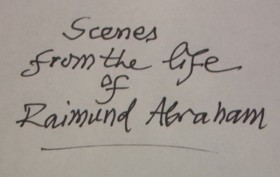


Mekas: Scenes from the Life of Raimund Abraham
First I have to make a confession, I didn’t make it to the end of the 5 hours long film! Not because I was bored, I just had a painful neck. But I did see about 240 minutes and I will be writing about those.
92 years old Jonas Mekas’ latest film Scenes from the life of Raimund Abraham is a portrait of his friend, the Austrian architect Raimund Abraham (1933-2010), who lived and worked in New York for more than four decades. Abraham was a radical and consistent architect and an important figure at the Cooper Union, a renowned progressive architecture school in New York.
Mekas generously sent the film to the Copenhagen Architecture Festival at his own initiative with a handwritten note saying that he thought this would fit in well with the festival. And it certainly did.

The film is not an integrated oeuvre in the sense of As I Was Moving Ahead Occasionally I Saw Brief glimpses of Beauty (2000), which is a true work of poetry. No, Scenes from the Life of Raimund Abraham is more of a footnote to the latter, a thread to be followed where the caption could be “Friendship”. And within the friendship lies the admiration for the work of the architect. The method is the same, an interweaving of old and new material, the new material filmed with a small handheld DV-camera (with the image and sound that goes with it), recordings of life as it happens around Mekas. A lot of cooking and eating meals, drinking wine in bars, gatherings of family and friends, discussions between friends about work, art or just this and that. But we also meet Abraham at work, the hectic end to the restoration of the Anthology Film Archive, Mekas’ lifework, and the construction of the Austrian Cultural Forum, designed by Abraham down to the smallest detail, which we follow until the opening in 2002. A crazy 26-floor building squished in on a tiny stamp-sized site on the crowded eastside of Manhattan, an impressive and beautiful piece of architecture.
The portrait is thus made up of a succession of scenes, all of them with the Mekas signature: filming of life as it really is, an exercise in how to capture the atmosphere. In his own words: «With video, my editing became choosing those moments where I succeeded in catching unique moments of real life » (interview in The Brooklyn Rail, 2010)
This is what makes it worth it staying for hours in the good company of Mekas and friends. You get very close to something real. It means that you get so much information from a scene like f. ex. where a mutual friend (who happens to be Peter Kubelka, the Austrian experimental filmmaker) has brought sausages from Austria and the treat is being shared late at night in the kitchen, or when Mekas climbs down a ladder with the running camera around his neck in to the hole that is to become Abrahams building, or when you get to sit through an entire lecture on architecture at Cooper Union. Glimpses of life that adds up to a portrait were you get something else than from a more traditional narrative.
Mekas’ method, his filming philosophy, becomes a sort of “cinema vérité” and maybe here is the antithesis to Joshua Oppenheimer’s (and Herzog’s) statement that all documentaries are performances. There is no fly on the wall, the camera is so integrated with the man that holds it, that we end up seeing with his eyes.
Jonas Mekas: Scenes from the Life of Raimund Abraham, 2015. 300 min.
You can visit The Austrian Cultural Forum New York on 11 East 52nd Street, Manhattan.
Interviews with Jonas Mekas:
http://www.dailymotion.com/video/xhx6oe_dicussion-avec-jonas-mekas_shortfilms